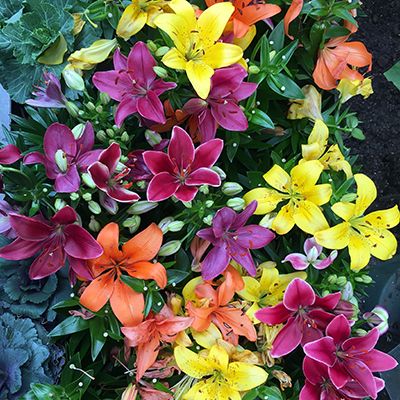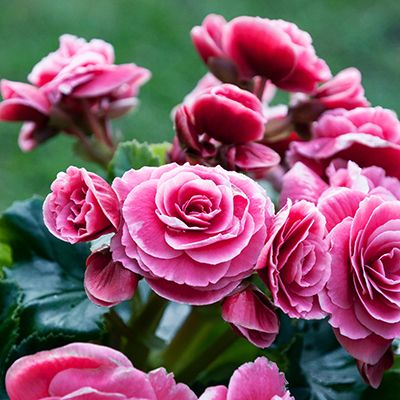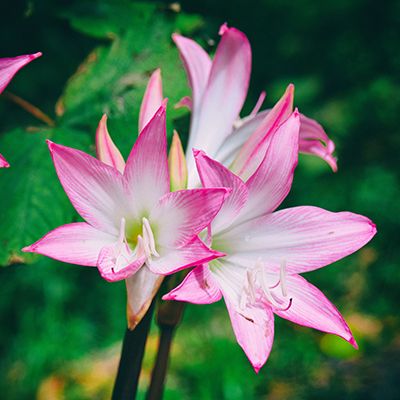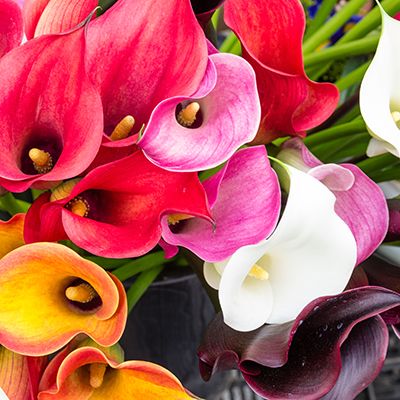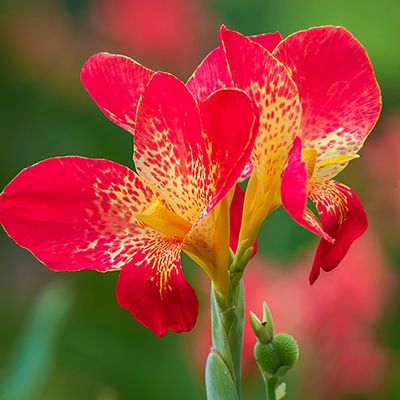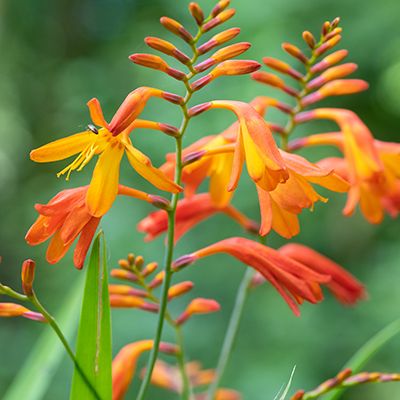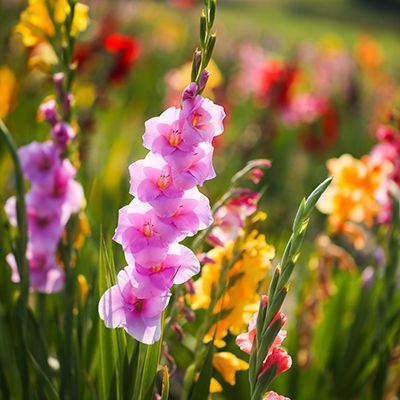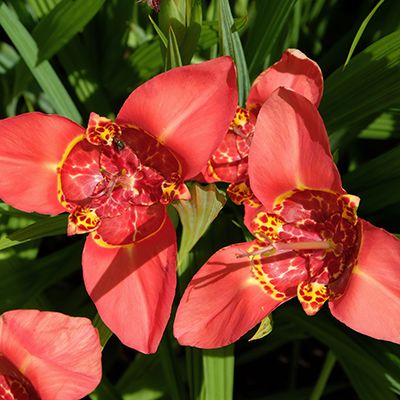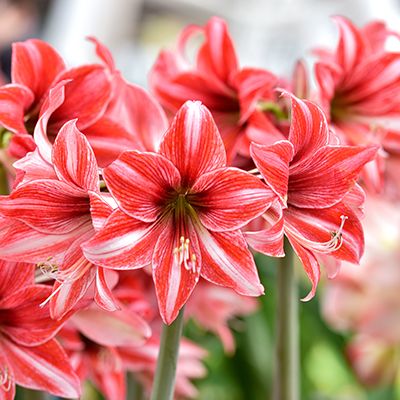
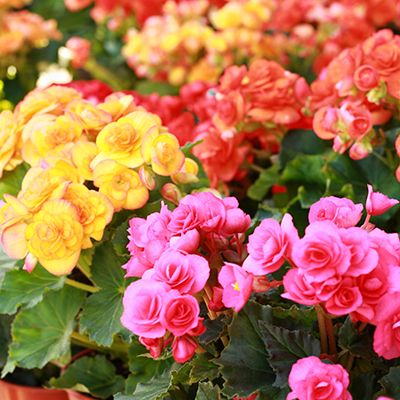
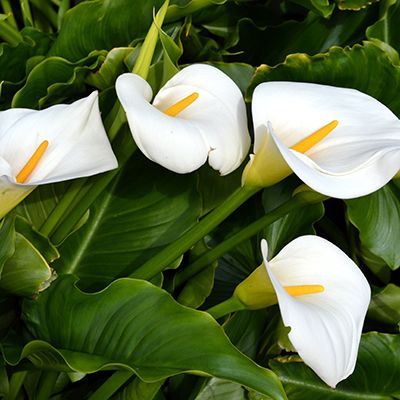
Summer Bulbs
The old bulb question arises again. We call them all bulbs for convenience and simplicity when some are actually corms or tubers or rhizomes. Regardless, they all are treated pretty much the same way. We are talking about Calla Lilies, Cannas, Dahlias, Gladiolus, Oriental/Asiatic Lilies, Crocosmia, Tigridia, Belladonna Amaryllis (Naked Ladies), Tuberose and Tuberous Begonias. Each of them has a special place in the garden but they all need some help in our Bay Area soil (see our Care Guide on Soil). Our heavy clay soil needs to be amended with organic matter so that our bulbs can get a foothold in their new home. If you can’t amend a large flower bed, you can amend each planting hole (at least one cubic foot) with one-third amendment such as Master Nursery Gold Rush to two-thirds native soil. Most of these flowers look best planted in a group so you may want to prepare a 4 foot by 4 foot or even a 3 foot by 10 foot bed (using the Soil Care Guide recipe) when planting your bulbs. All summer bulbs except the Oriental/Asiatic Lilies require full sun. Less than that will produce fewer, smaller flowers.
Gladioli don’t work too well in a mixed perennial bed so they are best relegated to the cutting garden where they can be cut for use in the home or as gifts. Glad bulbs should be planted about four times deeper than their thickness and four to six inches apart. When they are planted close together, the stems will support each other and not require staking. Try planting a dozen or more gladiolus at two week intervals which will extend the blooming period.
Gladiolus foliage should be left until it turns brown and then sometime later the bulbs with their little ‘bulblets’ are dug and stored for the winter.
Dahlias come in so many sizes and shapes that we have prepared a separate Care Guide for Dahlias alone. The main rule for the tall 'dinner-plate’ Dahlias is that you plant them about 12 inches deep with a supporting stake and then cover them as they grow through the soil.
Asiatic and Oriental Lilies prefer to have some afternoon shade and can be grown in between shrubs or perennials. They range in size from 15 to 48 inches in height so plan ahead! The shorter ones make attractive container plants especially when surrounded by Lobelia or Alyssum. Be sure to use a top quality potting soil such as Master Nursery Gardener’s Gold in your pots.
Tigridia is a sprightly low growing (to 18 inches) plant ideal for a corner or in-between trees or shrubs that need some summer color. They naturalize well and will provide color for years to come.
Crocosmia is similar to Tigridia but taller (up to 36 inches) with multiple flowers along its stem. It also naturalizes.
The Belladonna Amaryllis (Naked Ladies) blooms faithfully during the first three weeks of August. The bulbs multiply like rabbits and after several years will form a large cluster with one third of their mass above ground. Not to worry, they bloom just as well that way but will have to be divided after five or six years. The foliage appears after the flowers have finished blooming (hence the common name) and must be left until it turns brown. The Belladonna bulb is a source of that drug and in the past, ladies would make a tincture of the drug to drop in their eyes making the pupils especially large; and hence the name Belladonna translated beautiful lady!
Tuberous Begonias are usually grown in containers. Most gardening books will suggest a very complicated soil mix using leaf mold. Leaf mold is no longer available so you have to modify your recipe. We find that a portion of Master Nursery Gardener’s Gold to which one-quarter portion of Mini-Mulch and a bit less than a one-quarter portion of perlite has been added works very well. The shoot and top one-quarter of the Begonia bulb is left above ground when the bulb is planted. Water as needed and fertilize in June. In fall stop watering and let the foliage dry completely. Store the soil and dormant bulb in a cool dry area until the following March and then repeat the process.
Tuberose produces an especially fragrant flower which blooms in late summer. There may be several stalks per plant but the foliage is not particularly exciting and the snails will feast on it. Mr. Ed grows it in a container out in the back forty and when it is ready to bloom brings it up next to the front entrance where its fragrance can be enjoyed. When the bloom is finished, it goes out back to finish its growth for the year.
Cannas can get up to 7 or 8 feet tall and now are available with solid green leaves or leaves with multicolored yellow, red, and orange stripes. The leaves are almost as attractive as the flowers which are on long stalks above the leaves. As each stem finishes flowering, cut it to the ground and new stems will continue to grow throughout the summer and early fall. Every 3 or 4 years divide the clumps of bulbs to share or replant.
There are several species of Calla Lilies. The old fashioned one with the big white flower (which is really not a flower) and big green leaves is semi-deciduous depending on winter temperature. The smaller species with pink, yellow or rose colored ‘flowers’ are deciduous and disappear for the winter. All Callas will bloom in full to half day sun and can remain in place for at least five years. When they get crowded, they don’t bloom as well as earlier.
All summer bulbs require some water. They are somewhat drought resistant but will not bloom and survive if they receive no summer irrigation. A sprinkling of Master Nursery Rose and Flower or Gardner & Bloome Rose and Flower Fertilizers spread over the entire root area of the plants during early June will greatly benefit flower production.
If there is any down side to summer bulbs, it is that they are not gopher-proof like the Narcissus. Those of you in gopher country may need to use a gopher basket for your bulbs.
